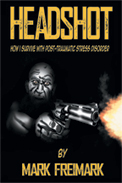
 |
The Mayo Clinic has a generalized definition of post-traumatic stress disorder (PTSD). It refers to it as a mental health condition that is triggered by a terrifying event—either experiencing it or witnessing it. What author Mark Freimark both experienced and witnessed in a cramped trailer house on a terrible Arizona morning could definitely be described as a terrifying event. Freimark’s PTSD resulted from it. It is a condition he still lives with to this day.
Freimark assisted two other police officers in answering a call regarding a potentially dangerous individual. The man had apparently stopped taking his medication and was holed up in his trailer home. After entering the trailer and attempting to talk the individual into coming out from behind closed doors, the officers suddenly found themselves in a firefight. The man rushed headlong and fired his gun into Freimark’s face at point blank range. When the smoke cleared, the man was dead, and Freimark suffered perhaps the cruelest fate of all. He was now destined to live his life with PTSD. In this memoir of the incident itself, the immediate days that followed, and the years that continued after that, Freimark recounts in vivid detail the agony of this terrible disorder. The moments of mayhem that actually occurred were fleeting, but the agonizing aftereffects have dogged the ex-police officer for over a decade. His first-person narrative is a harrowing account of the symptoms, pain, and problems that have been his constant companion since the day of the shooting.
There are a host of debilitating reactions that the author has suffered from—reactions he describes in detail as to their devastating effect on him and those around him. Nightmares, trembling hands, incontinence, apparitions, hallucinations, paranoia, depression, suicidal thoughts, and even suicidal attempts are all part of his history. He also relates his unremitting struggles with the bureaucratic institutions set up to ostensibly supply help, such as the police department itself, workers’ compensation, governmental agencies, and insurance organizations. He details additional problems caused by side effects to medications from ever-changing doctors he was forced to consult in his search for relief. And he doesn’t shirk from describing how his own attempts to self-medicate tended to make his condition even worse.
While the book requires more complete editing, there’s no lack of honesty and sincerity in the way he tells his story. Nor does he succumb to self-pity or defeatism. Freimark relates his own ways of coping with PTSD. He outlines the specifics of how he goes about getting through good days and bad, the behavioral system he employs, and his faith in a higher power than himself. It is the author’s hope that this book will help others who are dealing with this disorder, and those who love them, to have a better understanding of what PTSD is, what it can do to individuals, and how it can be dealt with. By telling his own story, he seeks to help many of his fellow sufferers, which is a worthy goal indeed.